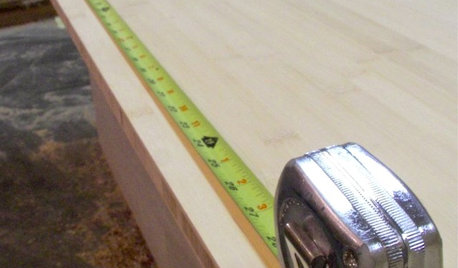Newbie compost questions
uscjusto
10 years ago
Related Stories

GARDENING GUIDESGet on a Composting Kick (Hello, Free Fertilizer!)
Quit shelling out for pricey substitutes that aren’t even as good. Here’s how to give your soil the best while lightening your trash load
Full Story
GARDENING GUIDESNo-Regret Plants: 5 Questions Smart Shoppers Ask
Quit wasting money and time at the garden center. This checklist will ensure that the plants you're eyeing will stick around in your yard
Full Story
ORGANIZINGPre-Storage Checklist: 10 Questions to Ask Yourself Before You Store
Wait, stop. Do you really need to keep that item you’re about to put into storage?
Full Story
SMALL HOMESHouzz Tour: An Illinois Loft Sparks Renovation Fever
Home improvement newbies (and newlyweds) find joy and a new income source while redoing their space themselves
Full Story
WOODWORKING7 Must-Have Measuring Tools for Woodworking
Whether you're a newbie DIYer or building cabinets from scratch, using the right woodshop tools makes all the difference
Full Story
GARDENING GUIDESHouzz TV: Make a Worm Bin for Rich Soil and Happy Plants
A worm-powered compost bin that can fit under a sink turns food scraps into a powerful amendment for your garden. Here’s how to make one
Full Story
FURNITURESmart Shopper: How to Judge Antique Furniture Quality
Pick the treasures from the trash without expert experience by learning how to evaluate antiques and what questions to ask
Full Story
MOST POPULAR10 Things to Ask Your Contractor Before You Start Your Project
Ask these questions before signing with a contractor for better communication and fewer surprises along the way
Full Story
TREE HOUSESTour a Fantastical Tree House for Kids and Adults Too
For an architect and a master woodworker, a magical tree house answers the question, ‘What would you do if you could do anything?’
Full Story
WALL TREATMENTSPick the Right Paint Finish to Fit Your Style
The question of finish may be as crucial as color. See which of these 9 varieties suits your space — and budget
Full Story


bibbus 7b
TXEB
Related Professionals
La Marque Landscape Architects & Landscape Designers · Leawood Landscape Architects & Landscape Designers · Sahuarita Landscape Architects & Landscape Designers · Wakefield Landscape Contractors · Arden-Arcade Landscape Contractors · Bell Gardens Landscape Contractors · Commack Landscape Contractors · Danvers Landscape Contractors · Fountain Valley Landscape Contractors · Lady Lake Landscape Contractors · Placerville Landscape Contractors · Ronkonkoma Landscape Contractors · Merrifield Landscape Contractors · Owings Mills Decks, Patios & Outdoor Enclosures · Stafford Decks, Patios & Outdoor EnclosuresuscjustoOriginal Author
TXEB
bibbus 7b
TXEB
Kimmsr
TXEB
toxcrusadr
uscjustoOriginal Author
TXEB
Mark99
TXEB